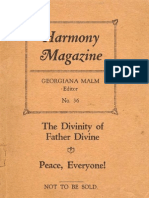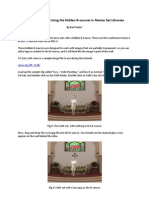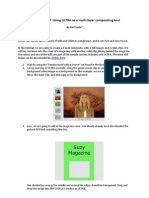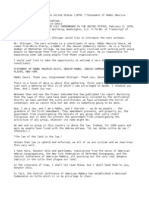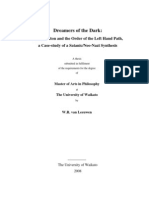Ogdoad
Ogdoad
Uploaded by
deus_primusCopyright:
Available Formats
Ogdoad
Ogdoad
Uploaded by
deus_primusCopyright
Available Formats
Share this document
Did you find this document useful?
Is this content inappropriate?
Copyright:
Available Formats
Ogdoad
Ogdoad
Uploaded by
deus_primusCopyright:
Available Formats
Ogdoad
From Wikipedia, the free encyclopedia
In Egyptian mythology, the Ogdoad (Greek "" the number eight) were eight deities worshipped in Hermopolis during what is called the Old Kingdom, the third through sixth dynasties, dated between 2,686 to 2,134 B.C. First it was a cult having Hathor and Ra; later changing to a cult where Hathor and Thoth were the main deities over a much larger number of deities; and even later, Ra was assimilated into Atum-Ra through a merger with Atum of the Ennead cosmogeny. The eight deities were arranged in four female-male pairs, the females were associated with snakes and the males were associated with frogs: Naunet and Nu, Amaunet and Amun, Kauket and Kuk, Huh and Hauhet. Apart from their gender, there was little to distinguish the female goddess from the male god in a pair; indeed, the names of the males are merely the male forms of the female name. Essentially, each pair represents the female and male aspect of one of four concepts, namely the primordial waters (Naunet and Nu), air or invisibility (Amunet and Amun), darkness (Kauket and Kuk), and eternity or infinite space (Hauhet and Huh). Together the four concepts represent the primal, fundamental state of the beginning, they are what always was. In the myth, however, their interaction ultimately proved to be unbalanced, resulting in the arising of a new entity. When the entity opened, it revealed Ra, the fiery sun, inside. After a long interval of rest, Ra, together with the other deities, created all other things. There are two main variations on the nature of the entity containing Ra: Egg variant The first version of the myth has the entity arising from the waters after the interaction as a mound of dirt, the Milky Way, which was deified as Hathor. In the myth an egg was laid upon this mound by a celestial bird. The egg contained Ra. In the original version of this variant, the egg is laid by a cosmic goose (it is not explained where the goose originates). However, after the rise of the cult of Thoth, the egg was said to have been a gift from Thoth, and laid by an Ibis, the bird with which he was associated. Lotus variant Later, when Atum had become assimilated into Ra as Atum-Ra, the belief that Atum emerged from a (blue) lotus bud, in the Ennead cosmogeny, was adopted and attached to Ra. The lotus was said to have arisen from the waters after the explosive interaction as a bud, which floated on the surface, and slowly opened
its petals to reveal the beetle, Khepri, inside. Khepri, an aspect of Ra representing the rising sun, immediately turns into a weeping boy - Nefertum (young Atum), whose tears form the creatures of the earth. In later Egyptian history, as the god Khepri became totally absorbed into Ra, the lotus was said to have revealed Ra, the boy, straight away, rather than Ra being Khepri temporarily. Sometimes the boy is identified as Horus, although this is due to the merging of the myths of Horus and Ra into the one god Ra-Herakty, later in Egyptian history. References Encyclopedie van de Mythologie. van Reeth, Dr. A. Tirion, Baarn: 1994 ISBN: 9051213042 Ewa Wasilewska Creation Stories of the Middle East, Jessica Kingsley Publishers 2000, pp.60ff. George Hart The Routledge Dictionary Of Egyptian Gods And Goddesses, Routledge 2005, p.113 Franoise Dunand, Christiane Zivie-Coche Gods and Men in Egypt: 3.000 BCE to 395 CE, Cornell University Press 2004 John D. Baines, Byron Esely Shafer, David P. Silverman, Leonard H. Lesko Religion in Ancient Egypt: Gods, Myths, and Personal Practice, Cornell University Press 1991
You might also like
- V5 Advantages and FlawsDocument10 pagesV5 Advantages and FlawsChapi Prost89% (9)
- Ptolus - Doctrine of Ghul PDFDocument31 pagesPtolus - Doctrine of Ghul PDFAmbre100% (1)
- Typhonian KemetDocument17 pagesTyphonian Kemetliaya76100% (3)
- The 42 Negative ConfessionsDocument2 pagesThe 42 Negative ConfessionsBenne James100% (2)
- The Neter SesenDocument205 pagesThe Neter SesenRas Nahmir Amun100% (3)
- The Osirian DramaDocument6 pagesThe Osirian DramaJohn Kenneth DanzyNo ratings yet
- The Key To All Sacred Mysteries Lies in Ancient EgyptDocument314 pagesThe Key To All Sacred Mysteries Lies in Ancient Egyptdonnah22445529100% (6)
- Fraternity of The Hidden Light - Mission, Purpose, Organisation, TrainingDocument8 pagesFraternity of The Hidden Light - Mission, Purpose, Organisation, Trainingdeus_primus100% (1)
- Goddesses and Gods of The Ancient EgyptiansDocument211 pagesGoddesses and Gods of The Ancient Egyptiansdeus_primusNo ratings yet
- The Origin of ChristianityDocument10 pagesThe Origin of ChristianityAnaiyahNo ratings yet
- Drewes, D. Early Indian Mahayana Buddhism I - Recent ScholarshipDocument11 pagesDrewes, D. Early Indian Mahayana Buddhism I - Recent ScholarshipvkasNo ratings yet
- The Secret Doctrine Book 1Document652 pagesThe Secret Doctrine Book 1mas2004100% (1)
- The Eye of HeruDocument3 pagesThe Eye of HeruTruman Dhanish100% (1)
- Neter: The Egyptian Word For GodDocument13 pagesNeter: The Egyptian Word For GodMiss FritzNo ratings yet
- Kushite Kemetic Origin of The Tree of LifeDocument1 pageKushite Kemetic Origin of The Tree of LifeNoxroy PowellNo ratings yet
- Music (Mathmatical Theory)Document8 pagesMusic (Mathmatical Theory)sovereignoneNo ratings yet
- The Entire Story of Jesus Stolen From Kemet EgyptDocument23 pagesThe Entire Story of Jesus Stolen From Kemet Egyptmario195mz83% (6)
- Harmony No 36 Divinity of Father DivineDocument36 pagesHarmony No 36 Divinity of Father DivineCopperStewart100% (1)
- Science of The Ankh 360 DegreesDocument1 pageScience of The Ankh 360 DegreesNoxroy Powell100% (1)
- The Holy Tablets, Tablet 6, V144-148Document8 pagesThe Holy Tablets, Tablet 6, V144-148HeruNo ratings yet
- Plutarch On Isis and Osiris Text, Cult, and Cultural AppropriationDocument27 pagesPlutarch On Isis and Osiris Text, Cult, and Cultural AppropriationKenneth Davis100% (1)
- Sekhef Henu em Maat (Seven Pillars of Ma'at)Document4 pagesSekhef Henu em Maat (Seven Pillars of Ma'at)Δαμοκλῆς Στέφανος100% (1)
- Black SupermanDocument2 pagesBlack SupermanJay-King Tut Guy100% (1)
- Kah BlablaDocument22 pagesKah Blablathaihuy15a2100% (1)
- Bona Abakhulu Base KhemuDocument21 pagesBona Abakhulu Base Khemublackyakub144No ratings yet
- Anidaho: N N W N W KDocument48 pagesAnidaho: N N W N W KaaronleescribeNo ratings yet
- The Science of 666 - GnosticWarrior PDFDocument3 pagesThe Science of 666 - GnosticWarrior PDFJulian Williams©™No ratings yet
- Book of LifeDocument60 pagesBook of LifeJesus Christ100% (1)
- Egypt Kemet - The Melanin Origins of The Spirit - Project I - Am - YouDocument2 pagesEgypt Kemet - The Melanin Origins of The Spirit - Project I - Am - Youmjsfwfes100% (1)
- Elefsinian MysteriesDocument16 pagesElefsinian MysteriesMixail MasonNo ratings yet
- EthersDocument6 pagesEthersCCNo ratings yet
- Anacalypsis - V - 2 Godfrey - Higgins 1927 643pgs REL - SMLDocument671 pagesAnacalypsis - V - 2 Godfrey - Higgins 1927 643pgs REL - SMLuncleben77No ratings yet
- Amentet Goddess of The Dead Personification of The WestDocument2 pagesAmentet Goddess of The Dead Personification of The WestCaroline SeawrightNo ratings yet
- Initiations To The Divine Mothers-1Document1 pageInitiations To The Divine Mothers-1Şöhret OlgaçNo ratings yet
- Enen Nazdaru Li Yasar-1Document8 pagesEnen Nazdaru Li Yasar-1Nathaniel AdamsNo ratings yet
- The Sun As The AxisDocument20 pagesThe Sun As The AxisNeb Nyansapo Noopooh100% (3)
- The Theban TheologyDocument1 pageThe Theban TheologyNabil RoufailNo ratings yet
- A Tour of Atlantis: or What Happens in The Astral RealmDocument56 pagesA Tour of Atlantis: or What Happens in The Astral RealmWayne O'BoogieNo ratings yet
- IseeExiledKemetics PDFDocument340 pagesIseeExiledKemetics PDFJacen BondsNo ratings yet
- Black Egyptians 15Document9 pagesBlack Egyptians 15Jeremy Johnson100% (1)
- Maat Goddess of Justice and Truth - I. . P. . H. . Guillermo Calvo Soriano, 33rd.Document64 pagesMaat Goddess of Justice and Truth - I. . P. . H. . Guillermo Calvo Soriano, 33rd.supremo7100% (1)
- Isis 7scorpionsDocument24 pagesIsis 7scorpionsHakiem ElMasryNo ratings yet
- Path of Initiation 05 Nychtemeron The Hours of Apollonius Part 1Document36 pagesPath of Initiation 05 Nychtemeron The Hours of Apollonius Part 1RogelioNo ratings yet
- 99 NazdirusDocument4 pages99 NazdirusJay-King Tut Guy100% (2)
- Dhwty Aka THTH Aka YhvhDocument6 pagesDhwty Aka THTH Aka YhvhNanya Faatuh El100% (2)
- America - Being The Latest and Most Accurate Description of The New World - John OgilbyDocument878 pagesAmerica - Being The Latest and Most Accurate Description of The New World - John OgilbyKurimeo Ban HawahNo ratings yet
- They Crucified Him Not, They Killed Him Not, With CertainDocument18 pagesThey Crucified Him Not, They Killed Him Not, With Certainagama_lNo ratings yet
- Amun The Egyptian GodDocument9 pagesAmun The Egyptian GodJames DriscollNo ratings yet
- The Book of Am-Tuat by E. A. Wallis BudgeDocument99 pagesThe Book of Am-Tuat by E. A. Wallis BudgeKofi Black100% (3)
- Ancient Egyptian Prayers and Ritual Worship: Youtube VideoDocument6 pagesAncient Egyptian Prayers and Ritual Worship: Youtube Videojohn kwameNo ratings yet
- Astral WorshipDocument50 pagesAstral WorshipTeaganFalak100% (1)
- TempleDocument98 pagesTempleRaymond M Kamundimu100% (1)
- Khu Ra QuranDocument8 pagesKhu Ra QuranGarvey Lives100% (1)
- Children of Ptah. Third Manuscript of the Richards' TrustFrom EverandChildren of Ptah. Third Manuscript of the Richards' TrustRating: 4 out of 5 stars4/5 (3)
- The Thüringia Codex: The Sacred Science of the Leopard Oracle Priest King of Het-Ka-PtahFrom EverandThe Thüringia Codex: The Sacred Science of the Leopard Oracle Priest King of Het-Ka-PtahNo ratings yet
- The Akshaya Patra Series Manasa Bhajare: Worship in the Mind Part ThreeFrom EverandThe Akshaya Patra Series Manasa Bhajare: Worship in the Mind Part ThreeNo ratings yet
- How Prosthetic Devices Are Changing Disabled Animals' LivesDocument14 pagesHow Prosthetic Devices Are Changing Disabled Animals' Livesdeus_primusNo ratings yet
- A User's Guide To Scrivener For WindowsDocument280 pagesA User's Guide To Scrivener For Windowsdeus_primusNo ratings yet
- A User's Guide To Scrivener For WindowsDocument280 pagesA User's Guide To Scrivener For Windowsdeus_primusNo ratings yet
- Setting Up Keying With Ultra Tutorial 15Document3 pagesSetting Up Keying With Ultra Tutorial 15deus_primusNo ratings yet
- A Brief Introduction To Tarot CardsDocument17 pagesA Brief Introduction To Tarot Cardsdeus_primusNo ratings yet
- Adobe Ultra CS: User GuideDocument130 pagesAdobe Ultra CS: User GuidejunkreportNo ratings yet
- Setting Up Keying With Ultra Tutorial 18Document2 pagesSetting Up Keying With Ultra Tutorial 18deus_primusNo ratings yet
- Setting Up Keying With Ultra Tutorial 8Document2 pagesSetting Up Keying With Ultra Tutorial 8deus_primusNo ratings yet
- Setting Up Keying With Ultra Tutorial 7Document4 pagesSetting Up Keying With Ultra Tutorial 7deus_primusNo ratings yet
- Setting Up Keying With Ultra Tutorial 14Document4 pagesSetting Up Keying With Ultra Tutorial 14deus_primusNo ratings yet
- Chronological Order of Holdstock's 'Mythago Wood' CycleDocument1 pageChronological Order of Holdstock's 'Mythago Wood' Cycledeus_primusNo ratings yet
- Alchemical LexiconDocument8 pagesAlchemical Lexicondeus_primusNo ratings yet
- Setting Up Keying With Ultra Tutorial 1Document4 pagesSetting Up Keying With Ultra Tutorial 1deus_primusNo ratings yet
- Enchanting - Beyond DisenchantingDocument2 pagesEnchanting - Beyond Disenchantingdeus_primusNo ratings yet
- Setting Up Keying With Ultra Tutorial 3Document6 pagesSetting Up Keying With Ultra Tutorial 3deus_primusNo ratings yet
- Alchemical Transformation in The Golden DawnDocument4 pagesAlchemical Transformation in The Golden Dawndeus_primusNo ratings yet
- The Muses and Three Graces of Greek MythologyDocument3 pagesThe Muses and Three Graces of Greek Mythologydeus_primus100% (1)
- The Seven Stages of AlchemyDocument2 pagesThe Seven Stages of Alchemydeus_primusNo ratings yet
- Class KWL Religion-2Document1 pageClass KWL Religion-2api-439469775No ratings yet
- Evidence For The Cults and Mythology of Marseilles From Its FoundDocument378 pagesEvidence For The Cults and Mythology of Marseilles From Its FoundMatheus FerreiraNo ratings yet
- Assumption of The GodformDocument9 pagesAssumption of The Godformdimmo100% (2)
- Maluk DasDocument6 pagesMaluk DasMohammad SaleemNo ratings yet
- The MysteriesDocument176 pagesThe MysteriesEric John100% (3)
- 1979 The Cult Phenomenon in The United States - Rabbi Maurice DavisDocument3 pages1979 The Cult Phenomenon in The United States - Rabbi Maurice DavisFrederick BismarkNo ratings yet
- Hymns in The Papyri Graecae MagicaeDocument27 pagesHymns in The Papyri Graecae MagicaecodytlseNo ratings yet
- The Role of Zeus Meilichios in ArgosDocument7 pagesThe Role of Zeus Meilichios in ArgosΟρεστης Πυλαρινος100% (1)
- Name and Origins: Isis (Document2 pagesName and Origins: Isis (Regie Rey AgustinNo ratings yet
- Pagan DivinitiesDocument8 pagesPagan DivinitiesRichmon Rey JundisNo ratings yet
- Glorantha ManifestoDocument214 pagesGlorantha ManifestoChaotique NeutreNo ratings yet
- Prehistoric Religion: General CharacteristicsDocument10 pagesPrehistoric Religion: General CharacteristicsLord PindarNo ratings yet
- This Content Downloaded From 31.5.41.66 On Tue, 03 Jan 2023 11:36:22 U1976 12:34:56 UTCDocument16 pagesThis Content Downloaded From 31.5.41.66 On Tue, 03 Jan 2023 11:36:22 U1976 12:34:56 UTCAndreea VasilacheNo ratings yet
- HecateDocument12 pagesHecateScribdTranslationsNo ratings yet
- Some Remarks On Water and Caves in Pre-Islamic Iranian ReligionsDocument10 pagesSome Remarks On Water and Caves in Pre-Islamic Iranian ReligionsDonna HallNo ratings yet
- Zeitgeist - Players' Guide PDFDocument37 pagesZeitgeist - Players' Guide PDFJohn FrangosNo ratings yet
- Fanatic Magazine 2Document12 pagesFanatic Magazine 2Psygnosis ReddevilsNo ratings yet
- V5 Blood Gods KS Manuscript Preview 2ADocument15 pagesV5 Blood Gods KS Manuscript Preview 2ASmith100% (2)
- Call of Cthulhu - Cults of The Dark GodsDocument2 pagesCall of Cthulhu - Cults of The Dark GodsZemblanityNo ratings yet
- Roel Van Leeuwen Thesis EditedDocument181 pagesRoel Van Leeuwen Thesis EditedOccult News Agency100% (3)
- The Call of Cthulhu by H.P. LovecraftDocument25 pagesThe Call of Cthulhu by H.P. Lovecraftblue_socksNo ratings yet
- Nips - PRE ISLAMIC Idols PDFDocument9 pagesNips - PRE ISLAMIC Idols PDFMZSA UANo ratings yet
- The Transition From The 21St To The 22Nd Dynasty in Thebes, Egypt As Manifested in Changes in The Wooden Funerary Stelae of The 22Nd DynastyDocument21 pagesThe Transition From The 21St To The 22Nd Dynasty in Thebes, Egypt As Manifested in Changes in The Wooden Funerary Stelae of The 22Nd DynastyAnonymous 5ghkjNxNo ratings yet
- WewelsburgDocument27 pagesWewelsburgDwarn66667% (3)
- Burroughs's Invocation To The Ancient Ones, Edited by Allen MackeyDocument2 pagesBurroughs's Invocation To The Ancient Ones, Edited by Allen MackeyALLEN MACKEY100% (1)
- Crypt of Cthulhu 51 1987.cryptic CosmicJukeboxDocument63 pagesCrypt of Cthulhu 51 1987.cryptic CosmicJukeboxNushTheEternal100% (5)



















